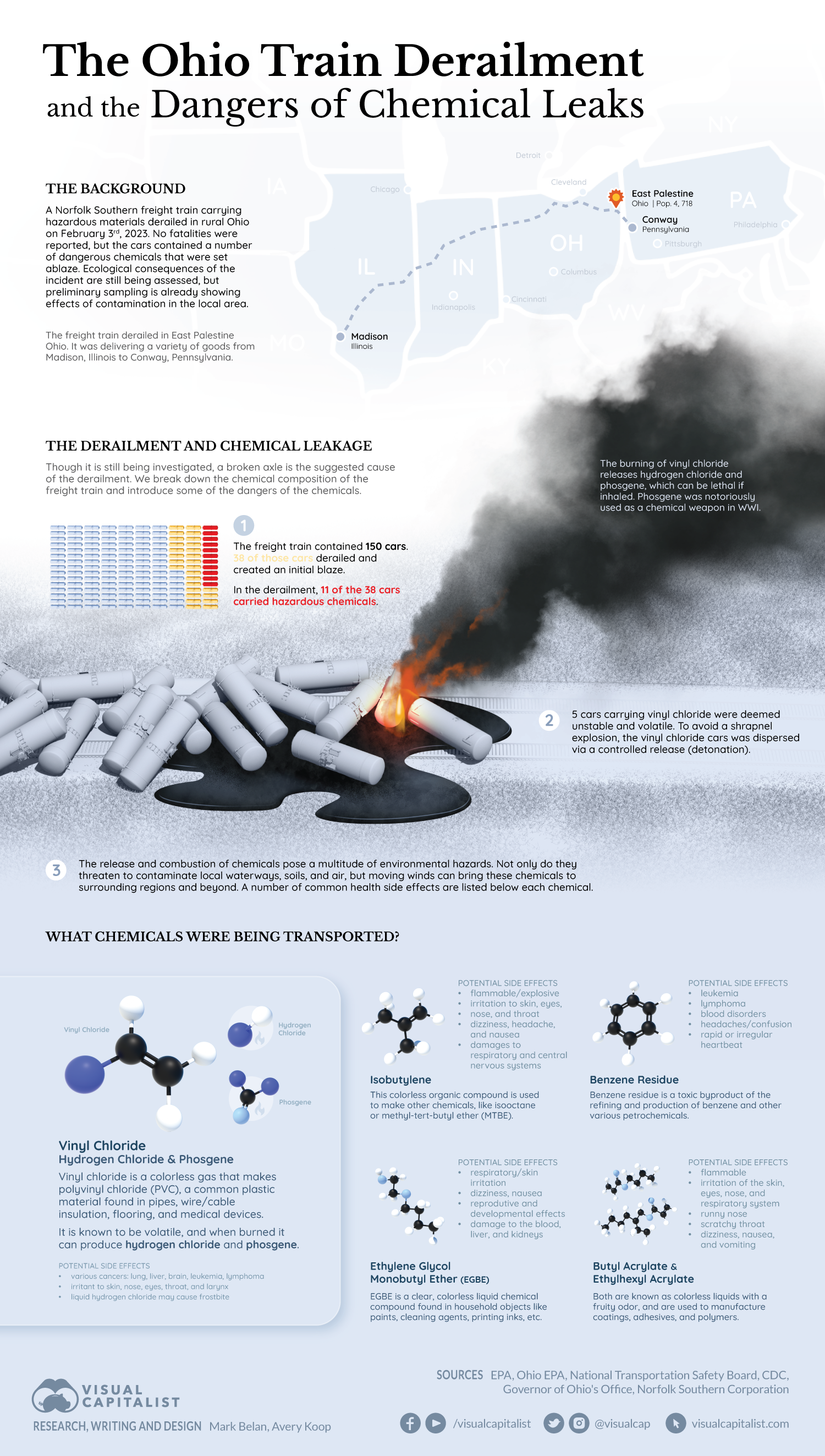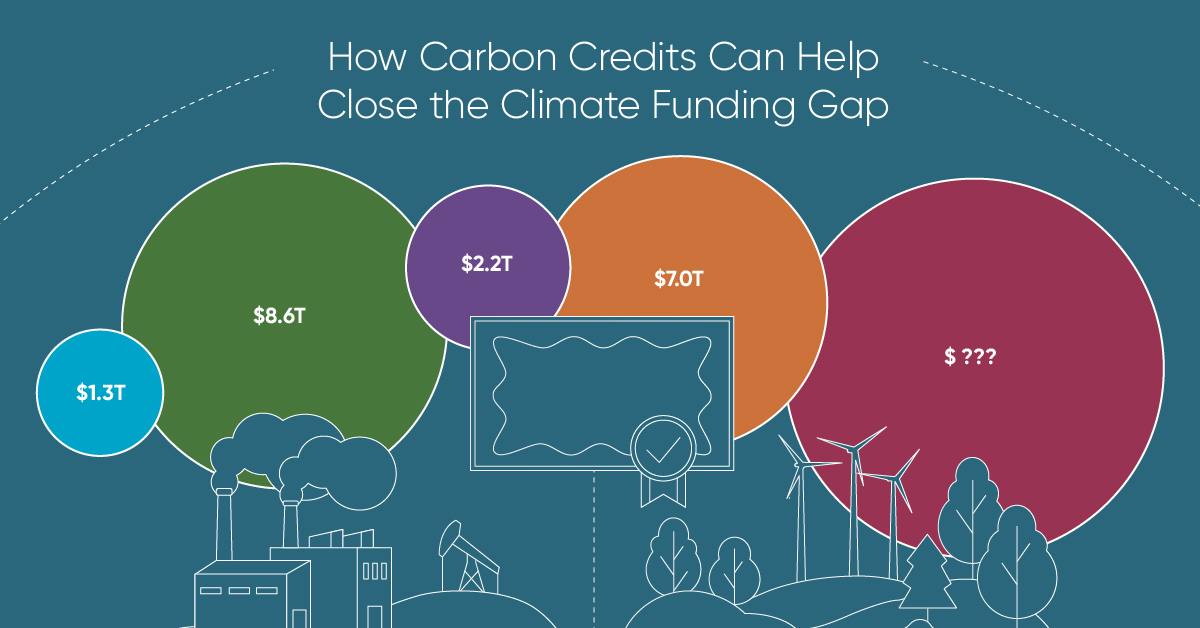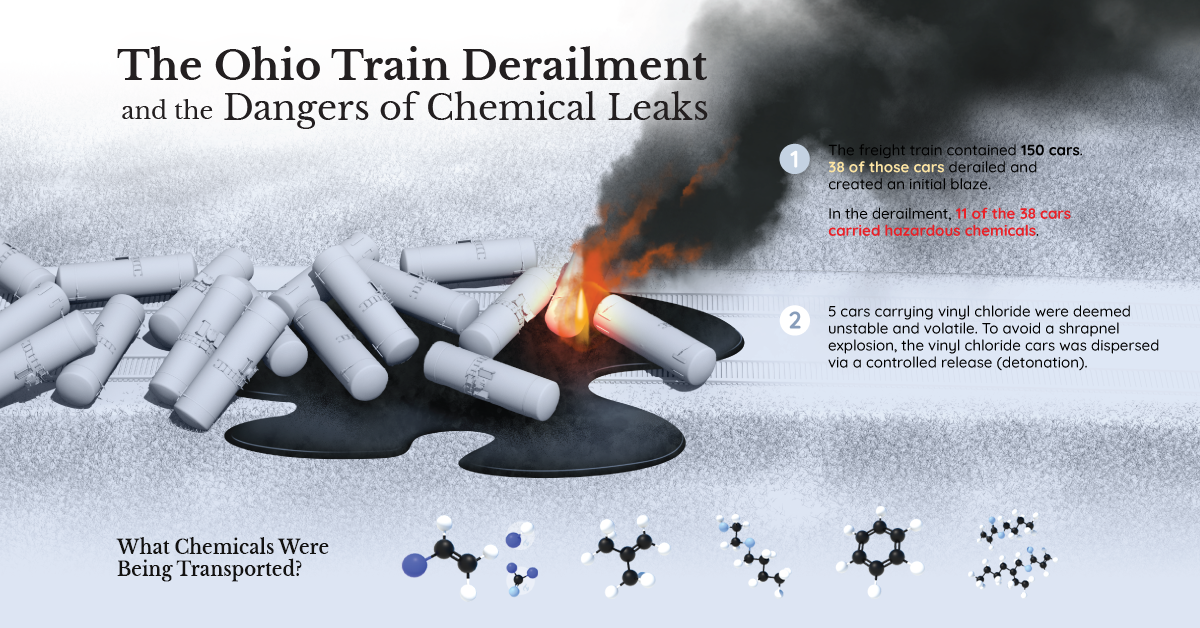Green
Explainer: What to Know About the Ohio Train Derailment

Explainer: What to Know About the Ohio Train Derailment
What started out as a seemingly commonplace train derailment near the border of Ohio and Pennsylvania in early February escalated into a serious threat to more than 4,000 people in the immediate area. Millions of people living in the vicinity of the derailment are also watching this situation closely as chemicals have made their way into the air and waterways.
Vinyl chloride, which was being transported on a number of the 150 train cars owned by Norfolk Southern, is a key cause for concern in the aftermath of the derailment. The chemical is a known carcinogen, and is dangerous when released into the environment.
In this piece, we’re providing a timeline, an explainer on the chemicals being carried by the train, the impact zone of the derailment and release of said chemicals, and the other basics you need to know.
What Was the Train Carrying?
The company that owns the train, Norfolk Southern, released a document detailing the train cars and what each carried, as well as whether or not it was damaged and/or derailed. Here are the highlights:
| Car Type | Load/MTY | Commodity | Haz Class | Status of Car |
|---|---|---|---|---|
| Hopper | Loaded | Polypropylene | Not in derailment pile | |
| Hopper | Loaded | Polypropylene | Not in derailment pile | |
| Hopper | Loaded | Polyethylene | lading destroyed by fire | |
| Hopper | Loaded | Polyethylene | lading destroyed by fire | |
| Tank Car | Empty | Residue lube oil | scrap pending C&P | |
| Tank Car | Loaded | Vinyl chloride, stabilized | 2.1 (FLAM. GAS) | car did not leak/cars vent product through the PRD and ignited/vent and burn performed |
| Tank Car | Loaded | Vinyl chloride, stabilized | 2.1 (FLAM. GAS) | car did not leak/cars vent product through the PRD and ignited/vent and burn performed |
| Tank Car | Loaded | Vinyl chloride, stabilized | 2.1 (FLAM. GAS) | car did not leak/cars vent product through the PRD and ignited/vent and burn performed |
| Tank Car | Loaded | Vinyl chloride, stabilized | 2.1 (FLAM. GAS) | vent product through the PRD and ignited/vent and burn |
| Tank Car | Loaded | Dipropylene glycol | fire impingement/no signs of tank breach | |
| Tank Car | Loaded | Propylene glycol | flame impingement, no tank breach found | |
| Tank Car | Loaded | Propylene glycol | tank breached/lost most of load | |
| Tank Car | Loaded | Diethylene glycol | had small leak from BOV, unknown amount of product in car | |
| Tank Car | Loaded | nos (ethylene glycol mono butyl ether) | COMB. LIQUID | unknown status |
| Hopper | Loaded | Semolina | in pile, destroyed by fire | |
| Tank Car | Loaded | nos (Ethylhexyl acrylate) | COMB. LIQUID | Car breached on head end/amount of product still in car pending |
| Hopper | Loaded | Polyvinyl | burned | |
| Hopper | Loaded | Polyvinyl | actively burning | |
| Tank Car | Loaded | Petroleum lube oil | double comp car/both breached/entire load lost | |
| Tank Car | Loaded | Petroleum lube oil | tank breached/lost most of load | |
| Tank Car | Loaded | Petroleum lube oil | flame impinged, may have had a small leak/will be determined when car is off loaded | |
| Tank Car | Loaded | Petroleum lube oil | flame impinged, small leak from top fittings, unknown amount left in tank | |
| Tank Car | Loaded | Polypropyl glycol | flame impinged, tank breached/ most of load lost | |
| Tank Car | Loaded | Propylene glycol | flame impinged, no signs of breach | |
| Tank Car | Loaded | Diethylene glycol | flame impinged, tank breached/ load lost | |
| Tank Car | Loaded | Diethylene glycol | flame impinged, lost unknown amount at this time from damaged BOV | |
| Tank Car | Loaded | Isobutylene | 2.1 (FLAM. GAS) | some flame impingement/no signs of breach |
| Tank Car | Loaded | Butyl acrylates, stabilized | 3 (FLAM. LIQUID) | Head breach/lost entire load (spill& fire) |
| Tank Car | Loaded | Petro oil, nec | flame impinged, small leak from VRV stopped, car still loaded | |
| Tank Car | Loaded | Additives, fuel | flame impinged, no sign of breach | |
| Hopper | Loaded | Polyvinyl | involved in fire | |
| Hopper | Loaded | Polyvinyl | involved in fire | |
| Tank Car | Loaded | Vinyl chloride, stabilized | 2.1 (FLAM. GAS) | car did not leak/cars vent product through the PRD and ignited/vent and burn performed |
| Box Car | Loaded | Balls, CTN, MEDCL | burning or has burned | |
| Box Car | Loaded | Sheet steel | burning or has burned | |
| Box Car | Loaded | Frozen vegetable | burning or has burned | |
| Tank Car | Empty | Benzene | 3 (FLAM. LIQUID) | damaged, fire impinged/ no breach |
| Tank Car | Empty | Benzene | 3 (FLAM. LIQUID) | damaged, fire impinged/ no breach |
| Tank Car | Loaded | Paraffin wax | flame impingement/no signs of breach | |
| Hopper | Loaded | Powder flakes | burned, extinguished | |
| Hopper | Loaded | Powder flakes | in line, upright, impinged | |
| Hopper | Loaded | Hydraulic cement | ||
| Autorack | Loaded | Autos passender | ||
| Box car | Loaded | Malt liquors | ||
| Box car | Loaded | Malt liquors | ||
| Box car | Loaded | Malt liquors | ||
| Box car | Loaded | Malt liquors | ||
| Box car | Loaded | Malt liquors | ||
| Box car | Loaded | Malt liquors | ||
| Box car | Loaded | Malt liquors | ||
| Box car | Loaded | Malt liquors | ||
| Box car | Loaded | Malt liquors |
Aside from dangerous chemicals, the train was carrying things like sheet steel, semolina, cement, malt liquor, and paraffin wax.
The Threat of the Chemical Substances
- Vinyl chloride: a gas which is commonly used to make PVC plastics. It is extremely flammable and produces toxic fumes when burned. It is also carcinogenic and can cause a myriad of health issues.
- Butyl acrylate: a liquid used for making sealants, adhesives, and paints. It can cause skin, respiratory, and eye irritation.
- Benzene residue: benzene is a highly flammable liquid. It is used to make things like rubbers, plastics, and dyes. It evaporates extremely quickly into the air and if exposed at high levels, it can cause dizziness, unconsciousness, tremors, irregular heartbeat, among other symptoms.
- Ethylhexyl acrylate: a liquid used to produce plastics and paint. It can cause respiratory and skin irritation. It can also produce a hazardous vapor under appropriate heat.
- Ethylene glycol monobutyl: a liquid that is primarily used as a solvent for inks and paints, as well as dry cleaning solutions. It is acutely toxic and can inflict serious or permanent injury. Vapors from the liquid can irritate the nose and eyes, and, if ingested, can cause vomiting and headaches.
- Combustible liquids
According to the CDC, many of these substances are frequently transported across the U.S.; benzene, for example, ranks in the top 20 chemicals by production volume in the country.
The Timeline
Friday, February 3rd: The train, which was heading from Madison, Illinois to Conway, Pennsylvania, was carrying various products from frozen vegetables to industrial chemicals. Near East Palestine, Ohio, just before the Pennsylvania border, 38 of the train’s 150 train cars derailed and subsequent fires caused damages to another 12. Additionally, 11 of the derailed train cars carried hazardous material, the most dangerous being vinyl chloride.
The derailment caused a large fire and ominous plumes of smoke over East Palestine, but there were no fatalities or injuries. According to the National Transportation Safety Board (NTSB), the cause of the derailment is still under investigation.
Saturday, February 4th: Environmental Protection Agency (EPA) crews began running air pollution and water runoff tests. They detected contaminated water in two streams, Sulphur Run and Leslie Run.
Sunday, February 5th: The EPA and Norfolk Southern’s contractors continued testing, and recovery efforts were underway at the contaminated water sites.
Monday, February 6th: Responders conducted a controlled burn of toxic materials to destroy the remaining vinyl chloride, which posed a threat of explosion and subsequent toxic fumes and shrapnel. Because of this the standing evacuation order was extended to include a larger area. From the Ohio governor’s announcement:
“The controlled release process involves the burning of the rail cars’ chemicals, which will release fumes into the air that can be deadly if inhaled. Based on current weather patterns and the expected flow of the smoke and fumes, anyone who remains in the red affected area is facing grave danger of death.” – Mike DeWine
Wednesday, February 8th: Just days later, the governor announced that it was safe for residents to return home as air quality tests were coming back clean.
In the last week: Reports have been coming in of people feeling symptoms related to the release of toxic chemicals. Additionally, the Ohio Department of Natural Resources, reported that 3,500 fish were found dead in Ohio waterways as a direct result of the spill from the train derailment.
The EPA, however, has screened the air quality inside more than 400 homes, finding levels to be safe. A statement from the regional director of the EPA said that: “Since the fire went out on February 8, EPA air monitoring has not detected any levels of health concern in the community that are attributed to the train derailment.”
On Wednesday, the 15th, Norfolk Southern representatives pulled out of a meeting with town officials, causing outrage among residents. The following day, EPA administrator, Michael Regan, visited East Palestine to quell the anger and fears, but residents are still unhappy and skeptical of the testing.
The largest remaining issue is that water quality connected to the Ohio River, which is still being monitored. The governor has recommended only drinking bottled water.
The Overall Impacts
The town of East Palestine is home to just over 4,000 people and the crash happened dangerously close to the city of Pittsburgh, PA. Contamination in the water supply have led to the deaths of thousands of fish and people are now complaining of reactions to the chemical leakage.
Norfolk Southern has set up an Assistance Center and donated over $1 million to help people cover costs of evacuation, as well as conducting extensive testing of air and water quality. The governor is now calling for tighter regulations on rail companies and a number of lawsuits have been filed against Norfolk Southern.
Green
How Carbon Credits Can Help Close the Climate Funding Gap
To keep a 1.5℃ world within reach, global emissions need to fall by as much as 45% by 2030, and carbon credits could help close the gap.

How Carbon Credits Can Help Close the Climate Funding Gap
Governments around the world have committed to the goals of the Paris Agreement, but their climate pledges are insufficient. To keep a 1.5℃ world within reach, global emissions need to fall by as much as 45% by 2030.
Bold and immediate action is essential, but so are resources that will make it happen.
In this graphic, we have partnered with Carbon Streaming to look at the role that the voluntary carbon market and carbon credits can play in closing that gap.
More Funds are Needed for Climate Finance
According to data from the Climate Policy Initiative, climate finance, which includes funds for both adaptation and mitigation, needs to increase at least five-fold, from $1.3T in 2021/2022, to an average $8.6T annually until 2030, and then to just over $10T in the two decades leading up to 2050.
That adds up to a very large number, but consider that in 2022, $7.0T went to fossil fuel subsidies, which almost covers the annual estimated outlay. And the world has shown that when pressed, governments can come up with the money, if the global pandemic is any indication.
Mobilizing Carbon Finance to the Developing World
But the same cannot be said of the developing world, where debt, inequality, and poverty reduce the ability of governments to act. And this is where carbon credits can play an important role. According to analyses from Ecosystem Marketplace, carbon credits help move capital from developed countries, to where funds are needed in the developing world.
For example, in 2019, 69.2% of the carbon credits by volume in the voluntary carbon market were purchased by buyers in Europe, and nearly a third from North America. Compare that to over 90% of the volume of carbon credits sold in the voluntary carbon market in 2022 came from projects that were located outside of those two regions.
Carbon Credits Can Complement Decarbonization Efforts
Carbon credits can also complement decarbonization efforts in the corporate world, where more and more companies have been signing up to reduce emissions. According to the 2022 monitoring report from the Science Based Targets initiative, 4,230 companies around the world had approved targets and commitments, which represented an 88% increase from the prior year. However, as of year end 2022, combined scope 1 and 2 emissions covered by science-based targets totaled approximately 2 GtCO2e, which represents just a fraction of global emissions.
The fine print is that this is just scope 1 and 2 emissions, and doesn’t include scope 3 emissions, which can account for more than 70% of a company’s total emissions. And as these emissions come under greater and greater scrutiny the closer we get to 2030 and beyond, the voluntary carbon credit market could expand exponentially to help meet the need to compensate for these emissions.
Potential Carbon Credit Market Size in 2030
OK, but how big? In 2022, the voluntary carbon credit market was around $2B, but some analysts predict that it could grow to between $5–250 billion by 2030.
| Firm | Low Estimate | High Estimate |
|---|---|---|
| Bain & Company | $15B | $30B |
| Barclays | N/A | $250B |
| Citigroup | $5B | $50B |
| McKinsey & Company | $5B | $50B |
| Morgan Stanley | N/A | $100B |
| Shell / Boston Consulting Group | $10B | $40B |
Morgan Stanley and Barclays were the most bullish on the size of the voluntary carbon credit market in 2030, but the latter firm was even more optimistic about 2050, and predicted that the voluntary carbon credit market could grow to a colossal $1.5 trillion.
Carbon Streaming is Focused on Carbon Credit Integrity
Ultimately, carbon credits could have an important role to play in marshaling the resources needed to keep the world on track to net zero by 2050, and avoiding the worst consequences of a warming world.
Carbon Streaming uses streaming transactions, a proven and flexible funding model, to scale high-integrity carbon credit projects to advance global climate action and UN Sustainable Development Goals.

Learn more at www.carbonstreaming.com.

-

 Green1 week ago
Green1 week agoRanking the Top 15 Countries by Carbon Tax Revenue
This graphic highlights France and Canada as the global leaders when it comes to generating carbon tax revenue.
-

 Green2 weeks ago
Green2 weeks agoRanked: The Countries With the Most Air Pollution in 2023
South Asian nations are the global hotspot for pollution. In this graphic, we rank the world’s most polluted countries according to IQAir.
-

 Environment2 weeks ago
Environment2 weeks agoTop Countries By Forest Growth Since 2001
One country is taking reforestation very seriously, registering more than 400,000 square km of forest growth in two decades.
-

 Green3 weeks ago
Green3 weeks agoRanked: Top Countries by Total Forest Loss Since 2001
The country with the most forest loss since 2001 lost as much forest cover as the next four countries combined.
-

 Markets2 months ago
Markets2 months agoThe World’s Top Cocoa Producing Countries
Here are the largest cocoa producing countries globally—from Côte d’Ivoire to Brazil—as cocoa prices hit record highs.
-

 Environment2 months ago
Environment2 months agoCharted: Share of World Forests by Country
We visualize which countries have the biggest share of world forests by area—and while country size plays a factor, so too, does the environment.
-

 Energy1 week ago
Energy1 week agoThe World’s Biggest Nuclear Energy Producers
-

 Money2 weeks ago
Money2 weeks agoWhich States Have the Highest Minimum Wage in America?
-

 Technology2 weeks ago
Technology2 weeks agoRanked: Semiconductor Companies by Industry Revenue Share
-

 Markets2 weeks ago
Markets2 weeks agoRanked: The World’s Top Flight Routes, by Revenue
-

 Demographics2 weeks ago
Demographics2 weeks agoPopulation Projections: The World’s 6 Largest Countries in 2075
-

 Markets2 weeks ago
Markets2 weeks agoThe Top 10 States by Real GDP Growth in 2023
-

 Demographics2 weeks ago
Demographics2 weeks agoThe Smallest Gender Wage Gaps in OECD Countries
-

 United States2 weeks ago
United States2 weeks agoWhere U.S. Inflation Hit the Hardest in March 2024












